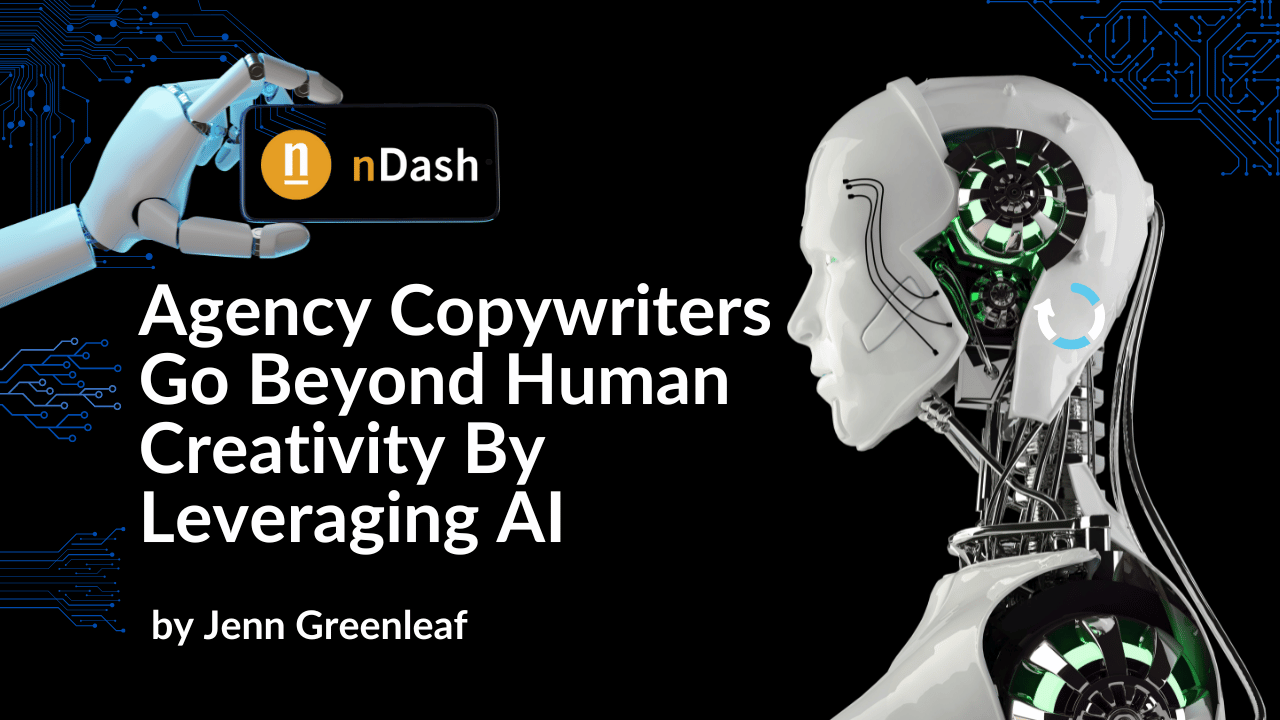Unlock the power of AI and discover how agency copywriters are revolutionizing the creative writing process to produce high-quality content quickly and efficiently.
How Agency Copywriters Successfully Integrate AI
Artificial Intelligence (AI) is rapidly transforming how businesses function. It has appeared in almost every industry, and marketing is no exception. The integration of AI in marketing isn’t new, but it’s still a topic of discussion for many marketers. One of the significant areas where AI has been making its presence felt is copywriting.
By leveraging AI, copywriters can improve their efficiency and effectiveness in generating more engaging, targeted, and personalized content. Here are some ways agency copywriters can successfully integrate AI into their work:
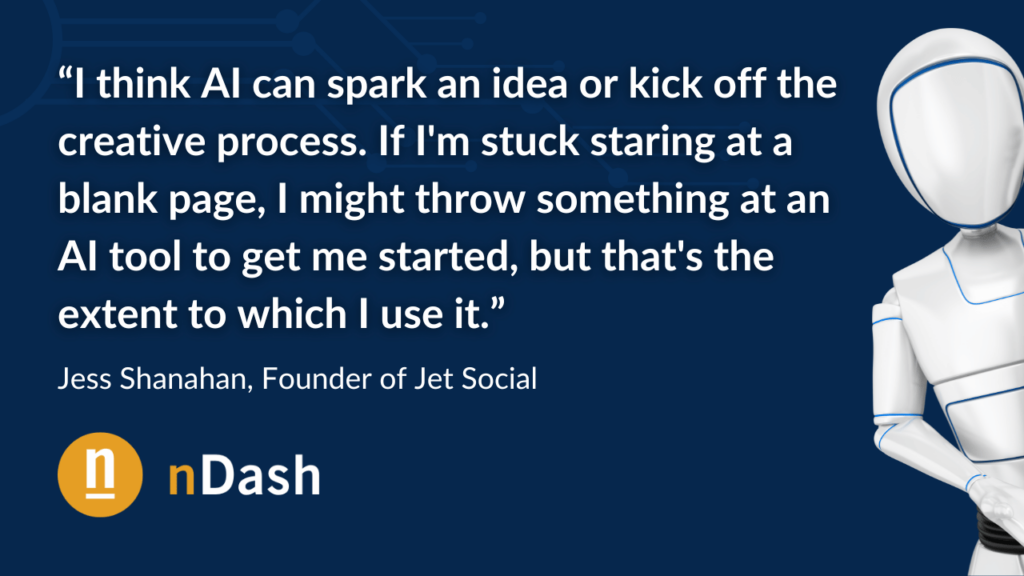
Content Ideation
Generating content ideas is time-consuming for copywriters. Jess Shanahan, the founder of Jet Social, shares her perspective. She explains, “I think AI can spark an idea or kick off the creative process. If I’m stuck staring at a blank page, I might throw something at an AI tool to get me started, but that’s the extent to which I use it.”
When asked about her take on integrating AI, Kara Detwiller, freelance content writer, shares, “I have seen some examples of freelancers using AI for support with idea generation, and that seems like a good idea.”
AI-powered tools like BuzzSumo, HubSpot Blog Idea Generator, and SEMrush Content Analyzer can help copywriters quickly generate content ideas based on the target audience, keyword research, and competitor analysis. This automation is a huge time-saver and allows copywriters to focus on creating high-quality content.
We also asked Jack Pittas, Co-Founder and President of PK Cyber Solutions, about AI. He tells us, “It is super helpful during editing and planning. As AI evolves, I see it offering tremendous upside to quality control and production during the content development process.”
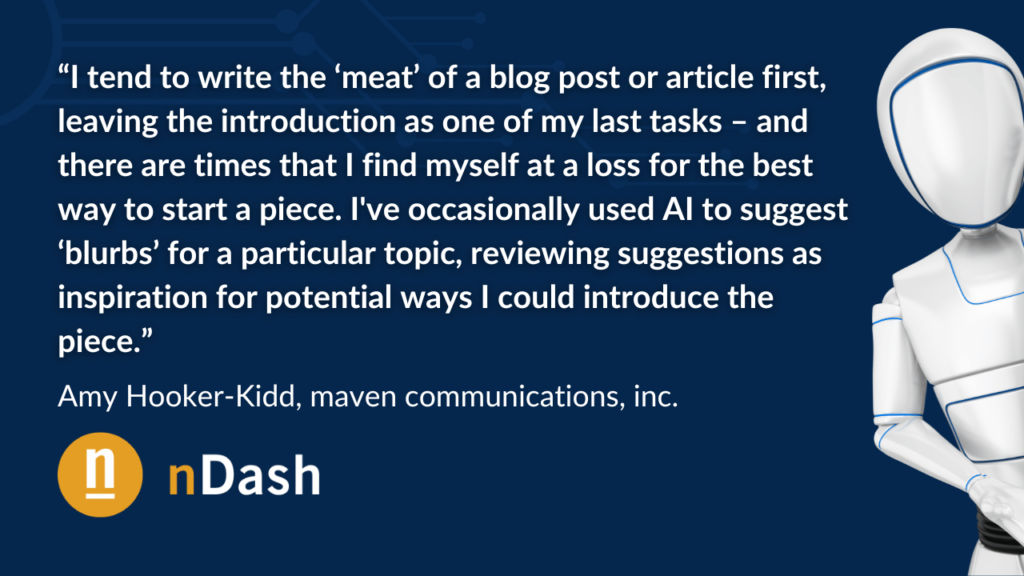
Copy Optimization
Tools like Yoast SEO and Rank Math help copywriters optimize content for readability, tone, and rankings. These tools analyze the writer’s content and provide suggestions to improve it. Such improvements include making it more concise, using a more active voice, or adding relevant keywords.
We asked Amy Hooker Kidd of maven communications, inc., to share her thoughts. She explains, “I tend to write the ‘meat’ of a blog post or article first, leaving the introduction as one of my last tasks – and there are times that I find myself at a loss for the best way to start a piece. I’ve occasionally used AI to suggest ‘blurbs’ for a particular topic, reviewing suggestions as inspiration for potential ways I could introduce the piece.”
Here are some ways AI can help optimize copy:
- Grammar and spelling: Identify and correct errors.
- Readability: Assess structure and suggest improvements to enhance readability. Examples include breaking up long paragraphs and using shorter sentences.
- Tone and style: Examine tone and style. It might suggest changes to make the content more formal, conversational, or persuasive.
Data Analysis
AI-powered analytics tools like Google Analytics, Kissmetrics, and Adobe Analytics can help copywriters understand their content’s performance and make data-driven decisions. These tools can provide insights into user behavior, performance, and conversion rates.
Here are some ways agency copywriters can use AI to analyze data:
- Audience research: Research the target audience, gathering information on demographics, interests, and online behavior using AI tools. Use this data for creating focused and impactful content.
- Copy analysis: These tools can examine the content of existing copy to identify recurring themes and tendencies that can inform future copywriting endeavors.
- Customer preference assessment: Use AI tools to assess customer behavior and preferences by analyzing website traffic, social media interactions, and other relevant data. This assessment can help identify which types of content resonate most with customers.
The Benefits That Agency Copywriters Experience When Leveraging AI
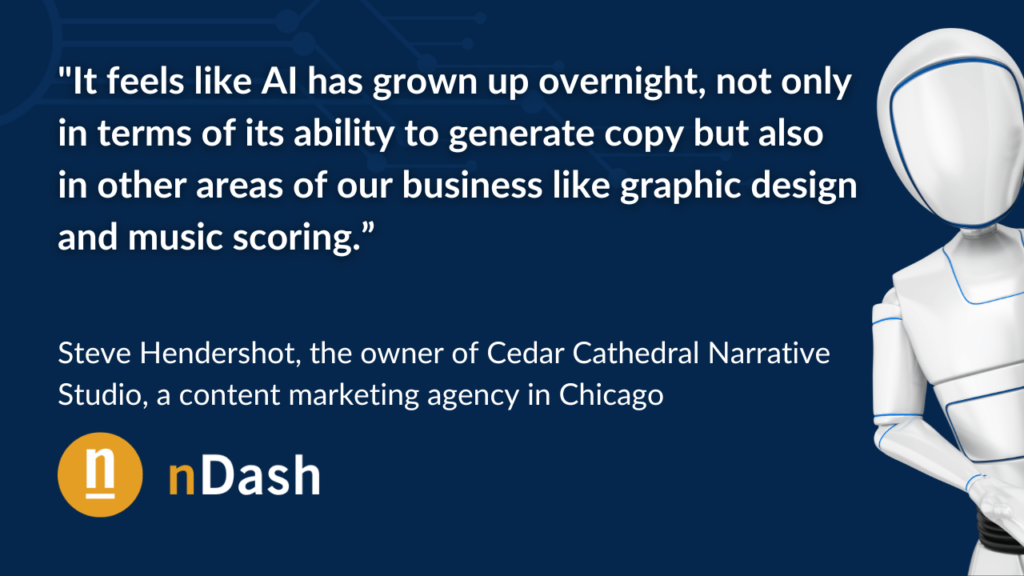
Brands must stand out in a sea of information; the right words can make all the difference. But as the demand for high-quality copy increases, so does the pressure on agency copywriters to deliver great content quickly and efficiently.
Leveraging the power of AI allows copywriters to streamline their workflow, unlock new levels of creativity, and provide more personalized content that resonates with audiences.
We talked to Steve Hendershot, the owner of Cedar Cathedral Narrative Studio, a content marketing agency in Chicago, about his thoughts on AI. He explains, “It feels like AI has grown up overnight, not only in terms of its ability to generate copy but also in other areas of our business like graphic design and music scoring.”
He continues, “It’s super weird, and from one perspective, it seems threatening. But these AI capabilities also open up lots of opportunities.”
Here are some benefits of leveraging AI:
Improved Efficiency
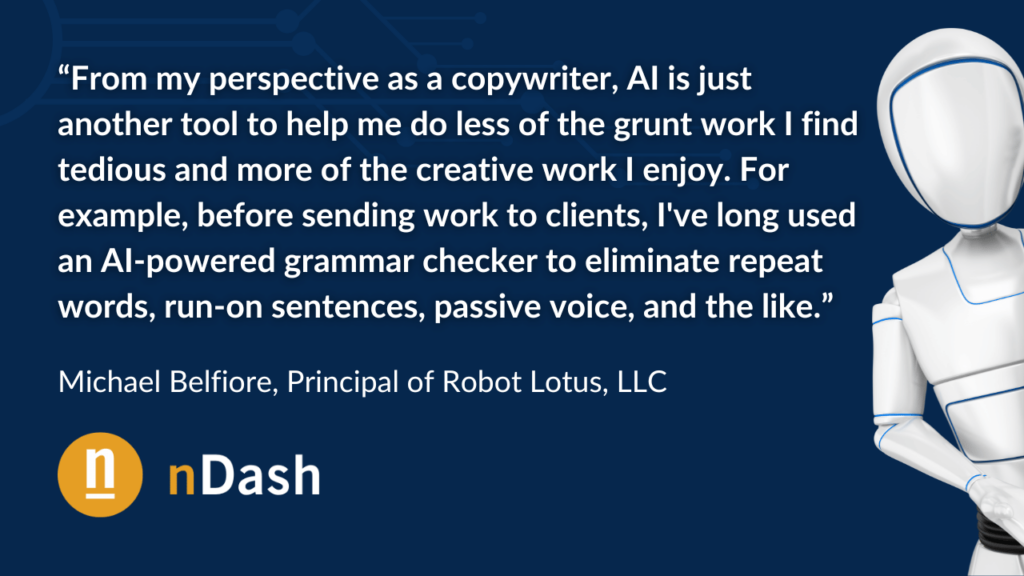
Using AI in agency copywriting provides a notable advantage by enhancing efficiency. We reached out to Michael Belfiore, Principal of Robot Lotus, LLC, to get his take. He explains, “From my perspective as a copywriter, AI is just another tool to help me do less of the grunt work I find tedious and more of the creative work I enjoy. For example, before sending work to clients, I’ve long used an AI-powered grammar checker to eliminate repeat words, run-on sentences, passive voice, and the like.”
He continues, “More recently, I’ve been using AI-powered writing tools at the front end of the writing process to help me summarize complex concepts as a starting point for my own writing, distill search results (which I then verify manually), and so on. Just as AI can help me polish finished work, it has the potential to help me get started on projects, saving me time and maximizing my creative energy.”
Personalization
With AI-powered tools like Crystal and Phrasee, writers can create highly personalized copy that speaks directly to target audiences. These tools can analyze data about your target audience’s demographics, preferences, and behaviors to create copy that resonates with them. This personalization can increase engagement and drive conversions.
In a recent blog by HubSpot, Cassie Wilson discusses how beneficial these tools are regarding informing ad copy. “AI can use predictive analytics to determine customer behavior and potential customers’ actions after seeing your ad.”
This information is invaluable when copywriters want to streamline workflows. She continues, “The massive amount of advertising information and customer behavior data gathered by AI can also display the next appropriate ad to your customers.”
Here are some ways AI can create personalized content:
- Dynamic content: Create dynamic content that changes based on user behavior. For example, an e-commerce website can use AI to display product recommendations based on the user’s browsing and purchase history.
- Email marketing: Personalize email marketing campaigns by analyzing user data and creating targeted messages based on the user’s preferences and behavior.
- Chatbots: Chatbots can personalize conversations with users by analyzing their past interactions and responding to their queries based on their unique needs.
- Landing pages: Analyze user data to create personalized, targeted content.
- Advertisements: Data analysis helps create targeted ads.
Consistency
Copywriting and consistency go hand-in-hand. You want your brand messaging to be consistent across all channels and touchpoints. With AI-powered tools, you can ensure your copy is consistent and adheres to your brand guidelines. These checks can help strengthen your brand identity and improve brand recognition. Examples of such tools include Red Marker and Writer.
Here are some ways AI can help agency copywriters maintain consistency:
- Brand consistency: Analyze a brand’s existing copy and branding guidelines and suggest improvements to ensure consistency in tone, voice, style, and messaging across all marketing materials.
- Grammar and spelling: As mentioned earlier, AI-powered tools can identify and correct errors in your copy, ensuring it’s error-free and consistent.
- Style guide adherence: Compare your copy against a style guide and suggest improvements to ensure that your copy adheres to the guidelines for tone, voice, grammar, and punctuation.
- Content auditing: Assess existing content and suggest improvements to ensure consistency in tone, voice, and messaging across all marketing materials.
- Automated editing: Automatically edit and proofread copy, ensuring that it conforms to the guidelines for consistency in tone, voice, style, and messaging.
Improved SEO
Tools like Keysearch and Google Search Console scrutinize search data. The results inform users regarding keywords and phrases their audience searches for.
Mike Kaput, Chief Content Officer at Marketing Artificial Intelligence Institute, writes, “AI doesn’t just find keywords for you. It helps you develop a rock-solid overall SEO strategy.” This analysis can help you create optimized copy for search engines, improving your rankings and driving more organic traffic to your website.
He continues, “Today, AI tools exist that can actually recommend what topics to cover whenever you create content. This helps you outrank the competition and avoid topic gaps in your content. AI will also break down for you related topics and searches to cover in new content.”
Here are examples of how AI helps with SEO:
- Analytics: Track metrics like traffic, bounce rates, and conversions.
- Keyword research: Look for search trends to identify the most relevant and high-ranking terms.
- Link building: Study backlinks and uncover opportunities.
- Website optimization: Identify technical errors and ways to improve user experience and ranking.
Cost-Effective
Leveraging AI in agency copywriting can be a cost-effective solution. AI-powered tools can perform many time-consuming tasks that copywriters typically perform, reducing the need for additional resources. This efficiency can help agencies save time and money while still delivering the highest-quality copy to their clients.
Here are some ways AI is a cost-effective solution for agency copywriters:
- Increased productivity: Increase productivity by automating repetitive tasks, like proofreading and editing. This frees up time for copywriters to focus on tasks like ideation and strategy.
- Improved accuracy: Improve accuracy by identifying errors and inconsistencies that may be missed by manual proofreading and editing. This can help reduce the risk of errors and the need for costly revisions and rewrites.
- Competitive advantage: AI helps businesses stay competitive by providing insights and suggestions for content optimization and personalization. These recommendations help businesses stand out in crowded markets and improve engagement and conversion rates.
Challenges and Limitations Agency Copywriters Face With AI
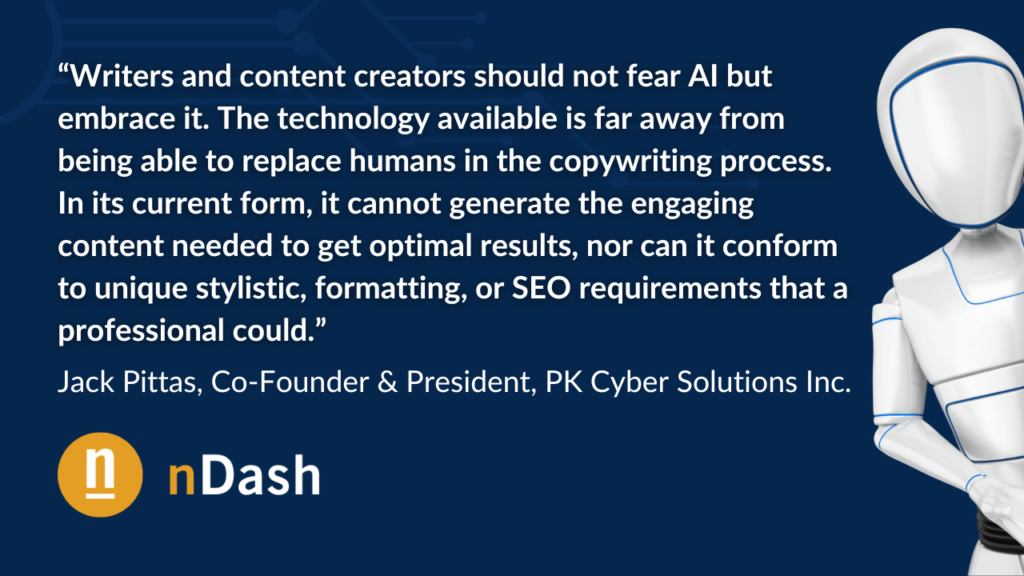
Artificial intelligence (AI) has significantly changed various industries, including marketing and advertising. One area of growing interest in AI is agency copywriting, which involves creating engaging and persuasive content for businesses and brands.
However, while AI presents significant potential benefits in this field, there are also notable challenges and limitations that marketers should be aware of.
Jack explains, “Writers and content creators should not fear AI but embrace it. The technology available is far away from being able to replace humans in the copywriting process. In its current form, it cannot generate the engaging content needed to get optimal results, nor can it conform to unique stylistic, formatting, or SEO requirements that a professional could.”
Steve adds, “The challenge now is to figure out whether and how to embrace what it does well and recognize and double down on the stuff it’s not so good at—things like strategy and reporting.”
Let’s explore these challenges and limitations and discuss how they affect the use of AI in agency copywriting.
The Limitations of AI in Capturing Emotional Nuance in Copy
One of the primary challenges of using AI in agency copywriting is that it may not capture the human touch. While AI can generate large volumes of content quickly and efficiently, it may lack the creativity, nuance, and emotion that come with human-generated content.
For instance, it may be unable to write captivating headlines, create memorable brand messaging, or understand cultural references that resonate with a specific audience. Jess adds, “I experimented with ChatGPT to create some social posts for my business, but I used none of its content. Everything came out bland, lacking in detail and finesse.”
Here are some examples of these limitations:
- Limited understanding of human emotion: While AI language models have come a long way in understanding human language, they still have a limited understanding of human emotion. The nuances and complexities of human emotion can be difficult for AI to capture accurately.
- Cultural differences: Emotions can be expressed differently in different cultures, and AI may not be able to capture these nuances accurately. Copywriters must be aware of cultural differences and ensure their messaging is appropriate for the target audience.
- Lack of creativity: AI language models are good at generating text based on patterns and rules but lack creativity and the ability to develop new and innovative ideas. Copywriters need to be able to think creatively to capture emotional nuances effectively.
Data Input Limitations
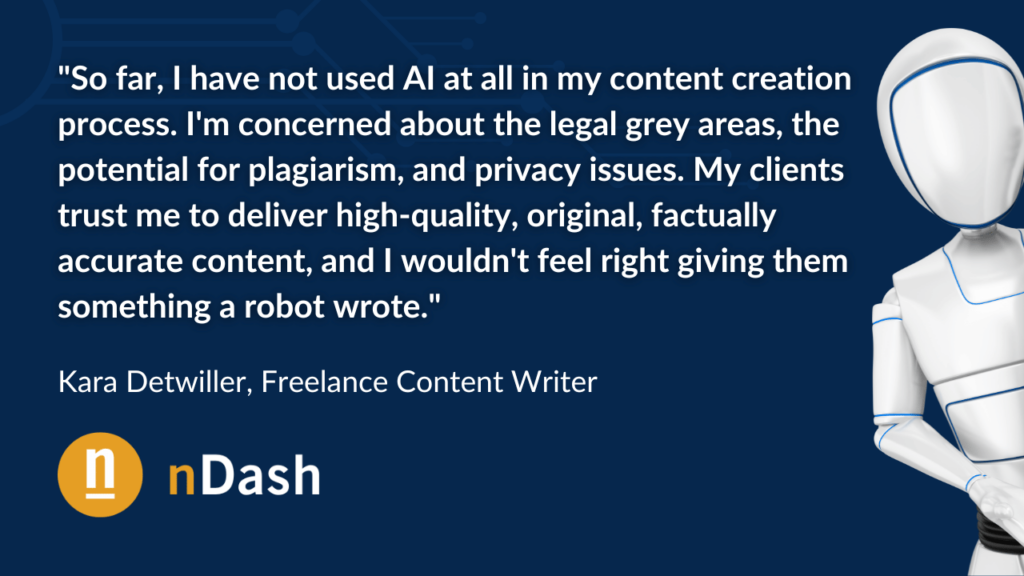
Another limitation of AI in agency copywriting is that it requires significant data input to produce high-quality content. Engineers must train AI systems with large datasets of existing content to learn how to generate compelling copy. But, this process can be time-consuming and expensive, particularly for smaller agencies that may not have access to such resources.
Kara shares, “So far, I have not used AI at all in my content creation process. I’m concerned about the legal grey areas, the potential for plagiarism, and privacy issues. My clients trust me to deliver high-quality, original, factually accurate content, and I wouldn’t feel right giving them something a robot wrote.”
Some examples of data input limitations writers might encounter:
- Quantity and quality of data: AI requires large amounts of high-quality data to function effectively. The AI model may produce flawed results if the data is incomplete, inaccurate, or biased. Additionally, the output quality is directly proportional to the quality and quantity of inputted data.
- Data bias: AI models can exhibit bias if their training data is biased. This can result in unfair or inaccurate predictions and recommendations.
- Interpretation of unstructured data: AI has difficulty interpreting unstructured data, like text, images, and videos, as it requires context to understand the meaning. People can easily understand the meaning of an image or text with limited information. However, AI needs a lot of training data to understand the context of such data types.
- Algorithmic transparency: Some AI models aren’t transparent, meaning it’s difficult to understand how they arrived at a particular conclusion or recommendation. This can make it challenging to identify and address errors or biases in the model.
Real-time Adaptability
AI-generated copy may not always adapt to changing market trends or respond to current events in real-time. In today’s fast-paced marketing environment, agencies must quickly pivot their messaging and copy to stay relevant and resonate with their audience. However, AI may struggle to keep up with the speed of these changes, resulting in outdated or irrelevant copy.
Copywriters using AI to create content may face several real-time adaptability challenges, including:
- Ensuring accuracy: Although AI algorithms can generate content quickly, ensuring that the output is accurate and error-free is challenging. Copywriters must review and edit the content to ensure it meets quality standards.
- Adapting to changes: AI systems are designed based on specific parameters and inputs. If there are changes in the content requirements or the target audience, it may be unable to adapt effectively.
- Balancing automation with creativity: Although AI can generate content quickly, it may not be able to produce content that’s truly creative and engaging. Copywriters must balance its use with their creativity to ensure the content generated is high quality.
Replicating a Brand’s Unique Voice
AI-generated copy may not always align with a brand’s unique voice or tone. Every brand has a distinct personality, and it’s essential to maintain consistency across all marketing channels. However, AI may find it challenging to capture and replicate the subtle nuances of a brand’s voice, resulting in copy that feels robotic or generic.
Some examples of challenges that copywriters face when trying to replicate a brand’s unique voice using AI include:
- Contextual understanding: AI systems may not always understand the context in which the content is created. For example, an AI system may not accurately replicate this tone in all situations if a brand’s voice is sarcastic or humorous. Copywriters must manually review and edit the content to ensure it’s appropriate for the intended context.
- Quality control: While AI systems can generate content quickly, the quality may not always meet the brand’s standards. Copywriters must review and edit the content generated by the AI system to ensure that it meets the brand’s quality standards.
- Over-reliance on AI: Copywriters may become over-reliant on AI and fail to exercise their creativity and writing skills. This can result in content lacking originality and failing to reflect the brand’s voice accurately. Copywriters must balance AI with their writing skills to ensure that the content generated is unique and engaging.
Balancing Efficiency with Creativity
While AI has many potential benefits for agency copywriters, it’s essential to recognize its challenges and limitations. By understanding these factors, agencies can effectively make informed decisions about incorporating AI into their workflows. Ultimately, the most successful agencies will likely balance leveraging AI’s efficiency and maintaining the human touch and creativity that make copywriting impactful.
Here are some examples of this challenge:
- Ensuring originality: AI tools generate content quickly but may lack originality. Copywriters must ensure that the content they produce using AI is unique and not plagiarized.
- Adapting to changing algorithms: AI tools rely on algorithms that can change over time. Copywriters must keep up with these changes and adjust their content to maintain search engine rankings and audience engagement.
- Avoiding robotic language: AI-generated content can sound robotic or unnatural. Copywriters must carefully review and edit the content to ensure it’s engaging and written authentically.
- Collaborating with other team members: Copywriters often work as part of a team, including designers, marketers, and developers. While AI tools can aid collaboration, ensuring that all team members are aligned with the same objectives is crucial.
- Avoiding the “one-size-fits-all” approach: AI tools can provide templates and pre-written content, but copywriters must avoid the temptation to use a “one-size-fits-all” approach. They must tailor the content to the specific needs and preferences of the target audience.
How Agency Copywriters Transform Content Using AI: Striking a Balance Between Efficiency and Creativity
Agency copywriters see many benefits when integrating AI into their workflows. Examples include increased efficiency and speed, data-driven optimization, and reduced bias and errors. Acknowledging the challenges and limitations that accompany this technology is crucial. While AI can enhance the creative process, it cannot replace the human touch entirely, and there is a need for personal oversight to ensure that brand voice and messaging are maintained.
Additionally, current AI technology has limitations in terms of language and creativity, and ethical concerns must be addressed. As the technology continues evolving, it’ll be important for agencies to carefully balance the benefits and limitations of AI to produce effective and ethical copywriting.
